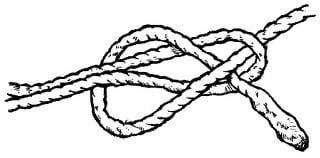Coming back up the ladders from the 3rd deck (2 decks below the hangar deck, naval architecture is a topic for another post) a short while ago, I met two lost gentlemen who asked if there was a way to get off the Yorktown...they were afraid their tour was going to end like the voyage of the Flying Dutchman. I told them to follow me and I'd lead them to the hangar deck (1st deck).
As we came up the ladder one of the gentlemen asked me, "How fast is a knot?" It seems a queer question, if you have never been exposed to ships or aircraft.

What he was really interested in was the speed traveling a nautical mile versus the speed of completing a statute mile. Our automobiles measure their speedometers in (statute) miles per hour, while nautical miles per hour or knots are a bit faster (notice I didn't say knots per hour as there is no such thing).
A nautical mile (NM) is the distance, following the curvature of the earth, from one minute of latitude (or arc) to the next. A statute mile is the straight line distance between the two, not taking into account the curvature of the earth.Because the straight line distance between two points is shorter than a curved path between them, a statue mile is 5280 feet while a nautical mile (at the equator) is 6076 feet.
Aircraft and sea vessels use nautical miles for navigation, because they cover great distances and must account for the curvature of the earth when planning. They also travel at relatively constant distances from the center of the earth. Over shorter distances, and when following the ups and downs of terrain, the difference between the straight line path and the curved path is negligible. Therefore, highways and other ground-based navigation are based on straight line measurements like statute miles or kilometers.
Conversion is very easy at a factor of 1.15, hence 100 knots of airspeed equals 115 miles per hour, 200 kts is 230 mph. Next post we'll look at the origination of the term knots, but only if I can find my way off the Yorktown sometime today...

